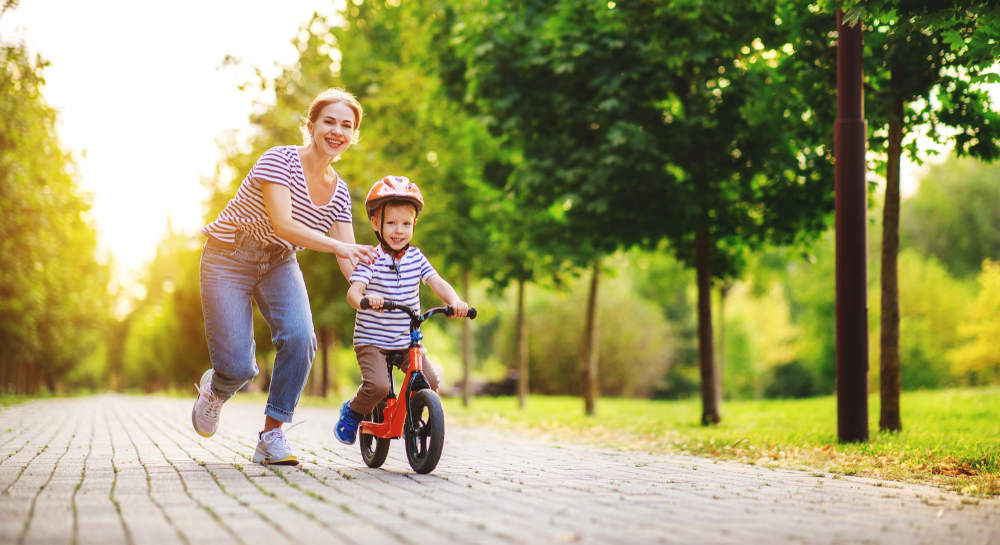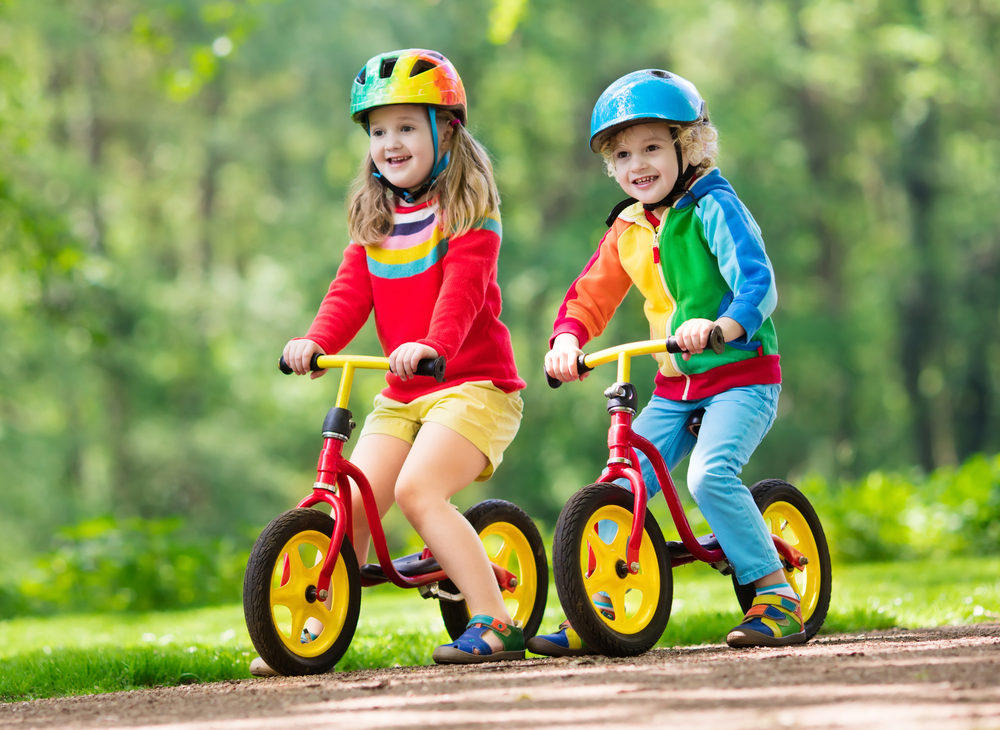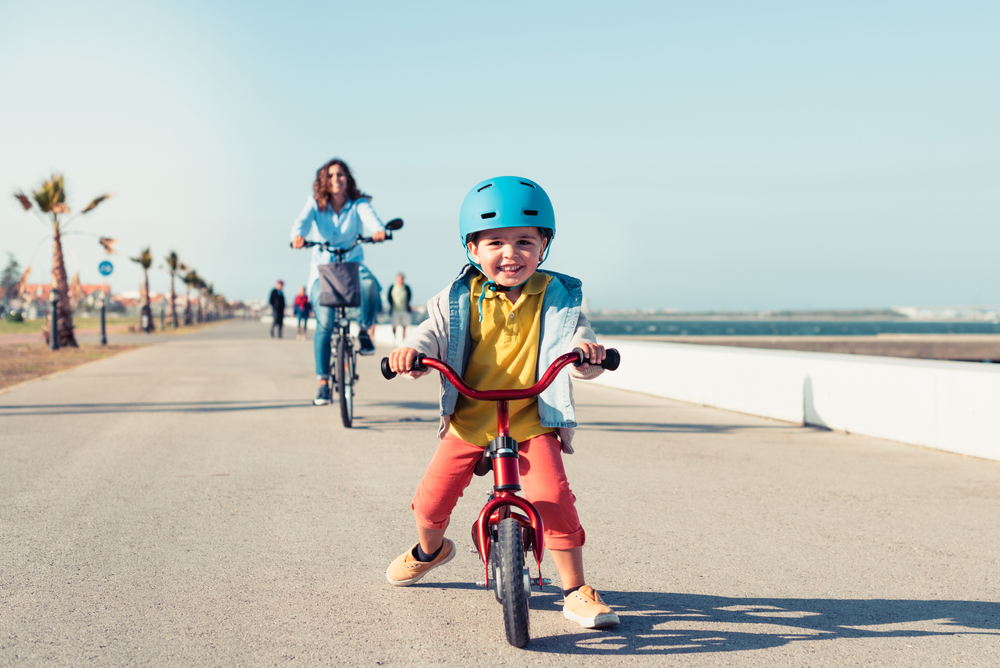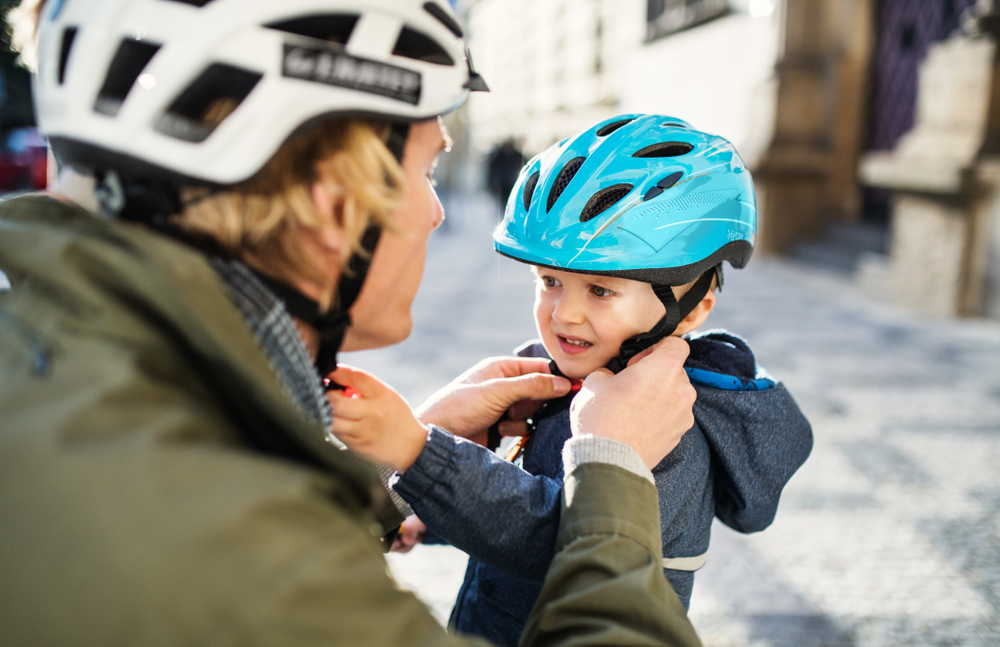There is no greater joy than watching your child learn, play and have fun. Seeing their little face light up as they take on new challenges is the greatest gift a parent can have.
Learning to ride a bike is an exhilarating experience for children. It’s a skill that lasts a lifetime and provides precious memories. Giving your child the gift of a bike at an early age supports their development and offers endless opportunities for family time and fun.
So, where to start? With a balance bike, of course!
You’ve probably noticed how popular balance bikes have become in recent years. Parents are turning to these adorable, innovative bikes for young children as a perfect introduction to a two-wheel pedal bike.
We have provided an age-by-age guide to balance bikes so you can feel confident when choosing the right one for your child’s age. At Kiddie’s Kingdom, we have a range of balance bikes to start every child off on their exciting bike riding journey.
What are balance bikes?
Balance bikes are the best introductory bikes for children. These bikes are cleverly designed with only the frame, handlebars, and wheels. They are without pedals, chains and sprockets, making them a more accessible alternative to traditional bikes.
Learning to ride a pedal bike can be complex and frustrating for some children, and for parents too, right? A balance bike allows a young child to develop their balance and coordination before graduating to a bigger, traditional pedal bike where they will need to master far more skills. When learning to ride a balance bike, children grow in confidence without fear and frustration.
To begin with, your child may want to walk beside the bike whilst holding the handlebars. They will eventually sit on the saddle and shuffle with their little feet as they become more confident. In time, your child will master gliding their feet along the floor to push the bike easily and confidently, lifting them off the ground and taking long self-assured strides. These bikes are simple yet effective in giving children a first taste of the joy of bike riding.
What are the benefits of balance bikes?
Introducing a bike to children offers so many benefits to themselves and the rest of the family. Children can learn independent cycling far sooner than with a traditional pedal bike, even with stabilisers because they don’t need to master so many skills at once.
Exercise is a toddler’s best friend
We all know that exercise is good for us, well it’s good for toddlers and pre-schoolers too! Starting children with regular physical activity early on can promote lifelong participation, leading to a healthy and active lifestyle, which is what we all want for our children.
As any parent knows all too well, young children have bags of energy! They need something constructive to do to burn off all that energy, and learning to glide around on a balance bike will undoubtedly do the trick, and hopefully give you a little break too.
Make memories
Pure and simple, riding a balance bike is fun! Children are likelier to get away from their indoor toys and get outside if they have something fun to play with. Entice them outside with a balance bike and make the good old outdoors exhilarating for your little one.
Enjoy spring time activities like gardening, feeding the ducks or an outdoor picnic whilst watching your little one ride around on their balance bike. Make beautiful memories in the spring sun as they glide to improved confidence and freedom. Balance bikes give your child the freedom and flexibility to learn to do things on their own and gradually build up to a more advanced bike when they’re ready, so you won’t have to deal with a frustrated toddler.
Because these bikes are simple, easy to manoeuvre, and designed to promote independence, the whole family, including grandparents and older children, can get involved. Without any tricky mechanisms to handle and not having to concentrate on too many skills at once, watch your little one ride off (or shuffle with their feet) into the distance without needing the support of an adult.
Physical development
Learning balance and coordination at an early age can help children in other areas of their development. With these transferable skills, your child can build a foundation to participate in various physical activities as they grow.
Balance and coordination are also necessary for injury prevention. As your child learns and develops their skills on a balance bike, they are less likely to hurt themselves in other situations such as when they’re playing outside or doing physical activities at school.
Furthermore, balance bikes help to develop a child’s core muscle strength and endurance. Their core muscles will be constantly engaged when they’re shuffling around on their balance bike. This type of physical activity is strenuous but enjoyable, so your little rider will be getting a good workout without even knowing it.
Easy transition
Learning to ride a pedal bike takes tremendous patience and skill. When a child is introduced to a balance bike first, it makes the transition to a pedal bike easier and sets them up for success. Introducing them to a bike that is more advanced than what they’re ready for, could put them off so a balance bike gives them a taste of what it feels like to have the wind in their hair before moving on to something bigger.
Cost-effective
If you choose the right balance bike, they are an excellent investment. Spend a little to gain a lot out of these clever toys with hours of free fun indoors or outdoors. Also, some balance bikes are adjustable to suit the needs of your growing child, therefore, lasting longer and saving you money.
So, if you’re starting to think about your one-year-old at Christmas time or for their first birthday, consider getting them a balance bike as it’s something that will not only light up their eyes on Christmas day but you will be giving the gift of a new skill and hours of fun too.
Tips for setting up and riding a balance bike.
So, you’ve chosen a perfect balance bike for your eager little rider, now what? Here is your guide on how to set up the balance bike and how to encourage your child to learn to ride it. They’re simple to set up with minimal fuss and they’ll be shuffling round the garden before you know it.
Setting up the balance bike
- Check that you have read the manufacturer’s instructions carefully and assembled the bike correctly.
- For a brand-new rider, put the seat as low as possible.
- They need to be able to straddle the seat with their feet firmly on the ground, with a slight bend in their knees.
- They should be able to take long strides.
- If the seat is too high for them, they will only be able to shuffle their feet along the ground.
- Adjust the bike regularly for growth spurts.
As a bonus, balance bikes offer convenience for parents. They’re light, so they can be carried effortlessly and small enough to be easily packed into the car for an adventure.
Learning to ride
- However tempting, try your best not to hold onto the balance bike. Your child can learn to ride it without physical assistance.
- Allow them to learn the feel of the bike themselves.
- Offering encouragement and praise keeps the experience positive.
- Allow your child to take things at their own pace; short but frequent opportunities on the bike are best for learning.
- If your child doesn’t sit on the seat immediately, that’s okay! Allow them to learn in their way.
- They might want to walk the bike, straddle the bike, shuffle along or glide their feet before taking big strides to push themselves along.
Safety first
As with any bike, there are a few safety tips to consider and protecting your child whilst riding is to important. Balance bikes are safe as long as just a few safety aspects are taken into consideration.
Bike helmets are essential and should be worn anytime a person is riding a bike, including young children on their balance bikes. It is an excellent way to get children into the habit of wearing safety gear when riding a bike, and it will also protect them from head injuries.
How to fit a helmet:
- Taking your time when fitting for the first time would be best. Try to do this ahead of time before taking a trip on the bike, so you aren’t rushed.
- Always read the manufacturer’s instructions when fitting a helmet.
- Place the helmet directly on top of your child’s head.
- The helmet should fit roughly 1 inch above their eyebrows.
- Helmets should be tightly fitted, and the straps should have even tension.
- The straps must form a Y shape under the ear.
- Once fitted, ask your child to move their forehead up and down or shake their head. If the helmet moves around, it is too loose and needs refitting.
Keep an eye on the helmet while your child rides their balance bike. The helmet needs adjusting if it becomes loose or moves around at all.
The Best Balance Bikes for 1-5-Year-Olds
Now that you have more information on a balance bike, it is time to choose the right one for your child’s ability and age. Not all balance bikes are suitable for every age and it’s important to choose the right one for your child’s current developmental age.
The main thing to consider when choosing a balance bike for your child is the height; remember that they should be able to sit on the saddle with their feet firmly on the ground and have a comfortable slight bend in their knees. For the bike’s longevity, it’s a good idea to look at the maximum height allowance of the bike’s saddle, allowing for growth.
Next, look at the features of different bikes. Some come equipped with footrests and additional safety features and are made of different materials from aluminium, wood or steel. Choosing a bike with these features comes down to personal preference, intended usage and the child’s age.
In addition to this, remember to think of yourself too when choosing a balance bike. Consider buying a lightweight bike when you need to carry it somewhere and a small, compact bike to store away in the garage or at home easily. Your toddler will love it, but you need to love it too.
Finally, choose a stylish, fun-looking bike you know your child’s eyes will light up when they receive it. You may be buying it for a birthday or a Christmas present, and you want the grand reveal to be memorable and special. Here is a list of our best bikes with their recommended age and why we know you and your child will love them.
Balance Bike for a 1-Year-Old
On average, babies start to walk at around 12 months. A balance bike can aid a baby in taking their first steps and becoming stronger, more confident walkers.
Kinderkraft Minibe Balance Bike
This bike is stunning and perfect for tiny riders. Suitable from 12 months old, this is ideal for children learning to walk.
The Kinderkraft Minibi bike is designed with adventure and exploration in mind. It is gentle and can be ridden both indoors and outdoors. Allow your baby to take their first steps with confidence with the support of this balance bike.
Haps First Ride Balance Bike
This balance bike is an ideal first bike for a 1–3-year-old. The bike is lightweight, soft and comfortable with flexible wheels, so there are no scratches or damage to your floor.
This bike has three wheels, making it easier for younger children to begin their biking journey. It offers more stability than a two-wheel balance bike, so your child will feel safe and supported.
Balance Bike for a 2-Year-Old
These bikes are the next step up from a teeny, tiny walker and are suitable for the more confident walkers with bags of energy.
Trybike-Steel 2 in 1 Balance Bike Vintage
The Trybike was designed with adjustability in mind. It is a bike with a difference and an edge.
This balance bike has a delicate vintage style and is suitable for children from 15 months to 6 years. It is perfect for your two-year-old as it converts from a trike to a bike, so they can continue using it for years. This bike is durable and has a quality finish.
Kinderkraft 3-in1 4trike
This is the perfect transition bike, as the tricycle features are recommended until around age two. It can then be converted into a two-wheel bike when your child is ready and can be adjusted in quick, simple steps.
The careful finishes and solid foam wheels increase your child’s safety while riding, offering additional reassurance. The Kinderkraft 3-in-1 4trike is made for convenience. It folds down to fit the stroller basket so you can pack it away when your child has finished playing with it and continue your day.
Balance Bike for a 3-Year-Old
These balance bikes are more advanced for slightly older children and some offer more features than balance bikes designed for younger children, such as steering wheel lock to prevent excessive and uncontrollable steering.
Kinderkraft Uniq Balance Bike
This balance bike offers a solid and safe frame made of strong birch wood, offering durability for your little rider. As your three-year-old grows in confidence on their bike and begins to experiment, rest assured that this bike has additional safety features.
Your child can get a firm grip on the non-slip rubber handlebars, and the handlebar lock limits the turning angle, reducing the risk of your child falling off. This bike is designed with safety and practicality in mind.
Balance Bike for a 4 and 5-Year-Old
These balance bikes are for children who are almost ready for a more advanced bike but need a little practice first and they look a little more like a conventional bike too.
Hape New Explorer Balance Bike
This bike is for little explorers and is more advanced than bikes suited for younger children. The Hape New Explorer Balance Bike has an ergonomic seat and frame geometry. The seat and the handlebars can be adjusted for a perfect fit. This bike is ideal for more confident young riders who are almost ready to transition to a pedal bike for fun free riding.
A final note
Balance bikes are a fun, adaptable and more accessible way for young children to learn to ride a bike. Balance bikes aid children’s development and help them easily transition to riding a pedal bike. These popular, innovative bikes are designed for children aged 12 months to 5 years old.
Enjoy watching your child become an early rider with a balance bike.




